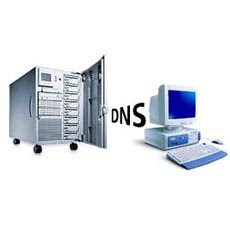In the mid-1980s enterprises became increasingly interested in ways to connect a rapidly growing population of personal computers. Novell proposed an approach using software to connect each workstation to a
network file server that would manage both the network and access to network resources. At the same time 3Com Corporation was creating Ethernet adapter cards, building hardware connectivity needed for such approach.
Novell grew upon the strength of its Netware operating system, used for file serving, and by the late 1980s had a 50% market share of local area networks. Seeing the potential growth in this arena IBM and Microsoft both introduced their own
file server strategies.
Twenty years after its peak, Novell and 3Com have virtually disappeared from the Server market; today disk servers (a NAS or a SAN) supplied by one of the leading vendors such as EMC or NetApp are typically attached to a file server running the Microsoft Windows or Linux operating systems. Large data centers, that serve millions of customers (such as Google's), run server farms on specialized equipment with large, complex operating systems.
Types of file serversA file server may be dedicated or non-dedicated. A dedicated server is generally designed specifically for use as a file server, with workstations attached for reading and writing files and databases. A workstation may share files with other workstations on the network directly however by turning on its "Server" service and then by creating a "Share" -- this process creates a non-dedicated file server that is primarily being used as a workstation.
File servers may also be categorized by the method of access: Internet file servers are frequently accessed by File Transfer Protocol (FTP) or by HTTP (but are different from web servers, that often provide dynamic web content in addition to static files). Servers on a LAN are usually accessed by SMB/CIFS protocol or NFS protocol. Database servers, that provide access to a shared database via a database device driver, are not regarded as file servers. Most file servers are simultaneously print servers too, as they provide access to printers via network. A single file serving computer may be accessible by multiple means: it may run an FTP server, an CIFS server, etc., serving the same files.
Design of file serversIn modern businesses the design of
file servers is complicated by competing demands for storage space, access speed, recoverability, ease of administration, security, and budget. This is further complicated by a constantly changing environment, where new hardware and technology rapidly obsoletes old equipment, and yet must seamlessly come online in a fashion compatible with the older machinery. To manage throughput, peak loads, and response time, vendors may utilize queuing theory to model how the combination of hardware and software will respond over various levels of demand. Servers may also employ dynamic load balancing scheme to distribute requests across various pieces of hardware.
The primary piece of hardware equipment for servers over the last couple of decades has proven to be the hard disk drive. Although other forms of storage are viable (such as magnetic tape and RAM) disk drives have continued to offer the best fit for cost, performance, and capacity.
StorageSince the crucial function of a
file server is storage, hardware has been developed to operate multiple disk drives together as a team, forming a disk array. A disk array typically has cache (temporary memory storage that is faster than the magnetic disks), as well as advanced functions like RAID and storage virtualization. Typically disk arrays increase level of availability by using redundant components other than RAID, such as power supplies. Disk arrays may be consolidated or virtualized in a storage area network (SAN).
FilersIn 1990s, introduction of specialized file serving devices, the NetApp filers, popularized the concept of network-attached storage (NAS). To this time, file servers were still implemented with general-purpose servers and OSes. NetApp changed this with introducing specialized network appliances, with a proprietary software and scalable to multiple disk enclosures holding tens or hundreds of disks grouped in multiple disk arrays. Filers later extended to non-file protocols, such as iSCSI, but still NAS is popularly perceived as mainly a file serving technology.
SecurityFile servers generally offer some form of system security to limit access to files to specific users or groups. In large organizations, this is a task usually delegated to what is known as directory services such as openLDAP, Novell's eDirectory or Microsoft's Active Directory.
These servers work within the hierarchical computing environment which treat users, computers, applications and files as distinct but related entities on the network and grant access based on user or group credentials. In many cases, the directory service spans many file servers, potentially hundreds for large organizations. In the past, and in smaller organizations, authentication can take place directly to the server itself.
Source: http://www.answers.com/topic/file-server


